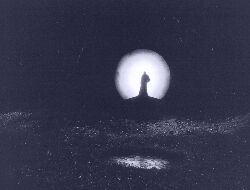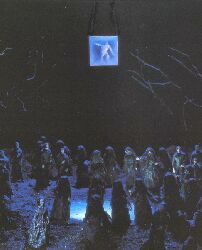At 4pm on Saturday afternoon, July 31, 1999, I settled into my wooden seat in the first row of the Festspielhaus. I popped a couple of Altoids and took a few deep breaths. I popped another couple of Altoids to replace the two I had just swallowed. My palms were sweating with excitement. From the dark came the silky ethereal sound of the violins and I felt I would be transported from my mortal existence. What broke the spell, as the curtains opened and we were "treated" to a staged prelude, was the sound of a backstage voice giving instructions to stage-crew members. There was no trace of this in the piano score which I had been reading over breakfast.
The stage was a blackened ashy moonscape--undulating hummocks, with a pool of water centre stage. Lohengrin was dark! The undulating floor a barren landscape of black ash disappearing into the dim recesses of that deep stage. The Männer von Brabant appeared in black 19th century long (and short) coats and the sun didn't appear at all.
Technology, in the form of hydraulic pistons, steel cable, and silent motors capable of moving great weights were brought into play for our amusement. Much thought and ingenuity had gone into this and I am sure, much expense. This would be no "stand and sing" performance to be sure.
There was no salivating over the cast list upon perusal of the programme. Gabriele Schnaut was Ortrud and of course is worthy, though the voice is rather strident. I haven't seen anyone better as yet, in the here and now. She does of course have a partner in the first scene of Act II, which is a favorite Wagner creation for me, as perfectly realised as Act I of Die Walküre. Her husband tonight was Jean Phillippe Lafont, who was unknown to me. John Tomlinson was King Henry, so I expected a lot of wobbly shouting. Roman Trekel sang the Herald and after his outing in Die Meistersinger I expected some fine good old-fashioned singing. Lohengrin, Roland Wagenführer, and Elsa, Melanie Diener, were unknowns. I wished them well.
Staging the prelude is of course, utterly daft and unnecessary. Lohengrin appearing as the prelude tries to make itself heard above the stage director's voice from the wings is not how it begins. Trust me, I have read the score.
He walked on, a mere mortal, at the back of the stage, on a hummock and did some long puzzled gazes..."where am I?" kind of thing. As the prelude ended and Pappano led the band way too fast into the opening measures of Act I, Lohengrin was thankfully obscured by the chorus emerging rapidly over hill and dale to focus on the Herald, who strode to the apron and delivered a beautifully sung summons.
The Herald's purpose was to prepare us for the arrival of King Henry and his guard. Up was not the direction I was looking in, but Henry came from on high. A platform the full width of the stage, lowered from the flies by steel cables, presented the seated King with about 40 or so silver-armored, spear-toting knights in attendance. A row of 16 silver broadswords reflected the spotlights back in my face. Visually this would be put in the "wow, cool!" category, which of course was exactly why it was done...and why not? It is theatre and not the real world, after all.
Luckily the cables were steel and quite rigid, for had they been made of rope, the wild teeth-loosening vibrato of John Tomlinson's first address would have caused the platform to swing back and forth, surely resulting in some of the queasier knights vomiting into their helmets. I tightened the strap on my sou'wester just in case. The poor man was howling. My heart sank. Back to him later.
The Telramund, Jean Phillippe Lafont, was built like a tank and had a similar sound to the T34 model. I came to dread any note longer than a 16th, for it would commence my chair to vibrate in its 123-year-old moorings. His voice was ugly; there was no music in it.
Elsa was summoned. A tall handsome young woman, Melanie Diener, making her Bayreuth debut, came forward and sang with a bright clean tone. She hit her marks and her notes, obviously well schooled in singing technique. While she was not an Elsa for the ages (and it is too early in her career, just three years into it, to expect definitive performances) she nonetheless earned her fee and took pains to be truthful to the score. She wasn't shrill nor wobbly and was therefore ahead of the game. She is German, from Schenefeld. "Einsam in Trüben Tagen" was well sung by Fräulein Diener--beautifully on pitch and with breath to spare.
The platform bearing the King and his vassals was cast into darkness and hoisted silently out of view to make way for the impending appearance of Lohengrin.  Our eyes were first arrested by the sight of a brightly lit perspex cube, moving forward from the gloom at the rear of the stage and high above it, suspended by cables. Within this frosty blue box (think: ice cube) was the figure of Gottfried, seeking a way out of his imprisonment. Meanwhile, at the rear centre of the stage a huge square black box appeared. As the chorus turned toward it, the box split in the middle, with a glare of blinding light. The crowd gathered before it. The tumultuous music melted into the Farewell to the Swan address (22 Lake St, Swanley, Kent) as Lohengrin emerged simply by walking through the chorus as they parted to reveal him.
Our eyes were first arrested by the sight of a brightly lit perspex cube, moving forward from the gloom at the rear of the stage and high above it, suspended by cables. Within this frosty blue box (think: ice cube) was the figure of Gottfried, seeking a way out of his imprisonment. Meanwhile, at the rear centre of the stage a huge square black box appeared. As the chorus turned toward it, the box split in the middle, with a glare of blinding light. The crowd gathered before it. The tumultuous music melted into the Farewell to the Swan address (22 Lake St, Swanley, Kent) as Lohengrin emerged simply by walking through the chorus as they parted to reveal him.
To be honest, I cannot recall what he was wearing. I know it wasn't a pair of Dockers and a Bulls tee-shirt, nor was it a tuxedo or golfing trousers, so you will have to use your imagination. I was trying to take notes on a manual typewriter but kept getting "shushed" by the other people in the row and eventually blew out my candle and put the typewriter on the hood of the orchestra pit.
Roland Wagenführer is handsome and has a pleasant voice. It is probably a wonderfully warm voice to hear in a small studio with piano accompaniment as he learns the roles. From his first words however it was obvious he was going to have to work hard to survive the evening. He lacks easy power and stamina.
John Tomlinson, as Henry, appeared to greet him at the apron of the stage. His voice was like black velvet, smooth and warm with a burnished tone that I could feel resonating in my skull just 20 feet or so from his mouth. I blinked. Was this the same man who had been howling with a wobbly dry voice just minutes before up on the platform? Indeed it was!! He sounded wonderful. Does he always start off badly and then warm up into a state of magnificence? I looked forward to his every utterance from then on. He must have been magnificent in the past in this house.
The battle between Lohengrin and Telramund was played out as they were surrounded by the chorus and spotlights picked out the clashing silver swords above the heads of the crowd. Very effective staging. If you had money on Telramund, as I had, then you lost your shirt. I took mine off and handed it to Parsifal13, but kept my tie around my neck for the sake of decorum. The finale of Act I is of course a big noisy affair, with all the principals and chorus wailing. The trumpet flourishes, while the strings saw rapidly away, skidding around the mountain bends in the music, make my heart pound and that kind of uncontrollable adrenaline rush brought on by great music is what keeps me coming back for more. The emphatic accents to round off the Act were pounded home with vigour as the Wagner curtains closed.
A brief moment of silence. Then the sound of the typewriter sliding off the pit hood and the unmistakable "ching" of an Olivetti as it struck Maestro Pappano on the head.
To be continued......
ô¿ô
|
Literary content: Copyright: © 1999 Norris Adair |
| TOP of PAGE |
Welcome Page | Site Map
| Website Design by: |